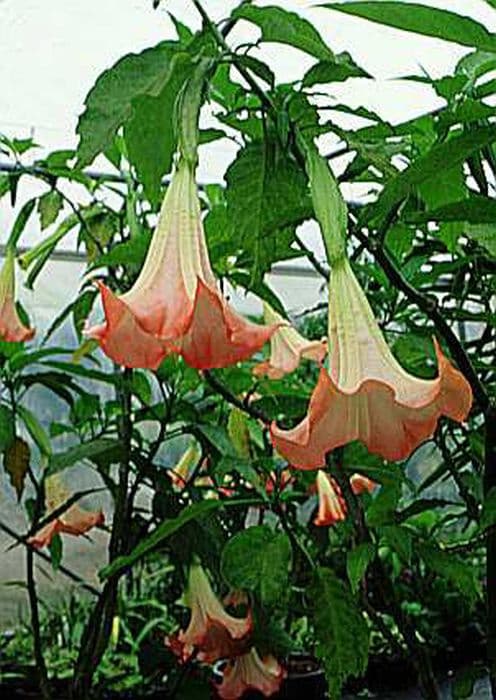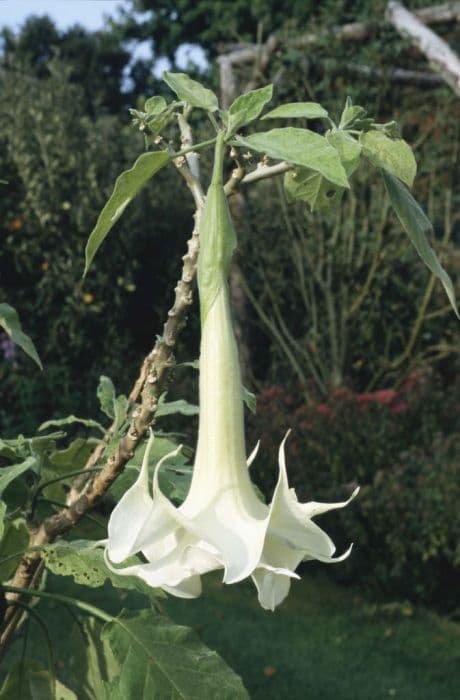Violet Pichi Fabiana imbricata f. violacea hort.

ABOUT
The plant known as pichi is a visually striking evergreen shrub. It possesses a dense, bushy form with intricate, needle-like leaves that closely resemble those of conifers, giving it a fine, feathery texture. The leaves exhibit a vibrant green color, adding to its allure. In the right conditions, it produces an abundance of small, funnel-shaped flowers that can range in color from a pale lilac to a more pronounced purple, contributing a burst of color to its foliage. The overall appearance of the pichi is one of delicate foliage combined with attractive blooms, which makes it a popular choice for ornamental uses in gardens.
About this plant
 Names
NamesSynonyms
False Heather, Violet-flowered Pichi
Common names
Fabiana imbricata var. violacea, Fabiana violacea.
 Toxicity
ToxicityTo humans
The most common name for Fabiana imbricata f. violacea hort. is Pichi. Information regarding the toxicity of Pichi to humans is not well-documented in readily available sources as of my last update. Since comprehensive data on its toxicity is lacking, it is advisable to handle the plant with care and avoid ingesting any part of it to prevent potential adverse effects.
To pets
The most common name for Fabiana imbricata f. violacea hort. is Pichi. Similar to the information available for humans, detailed data on the toxicity of Pichi to pets is also not extensively documented. Pet owners should therefore exercise caution, preventing pets from ingesting parts of the plant, as it could potentially be harmful, and consult a veterinarian if ingestion occurs.
 Characteristics
CharacteristicsLife cycle
Perennials
Foliage type
Evergreen
Color of leaves
Green
Flower color
Purple
Height
5 feet (1.5 meters)
Spread
3 feet (0.9 meters)
Plant type
Shrub
Hardiness zones
8
Native area
South America
Benefits
 General Benefits
General Benefits- Decorative Appeal: Fabiana imbricata provides visual interest in gardens with its attractive, violet-hued flowers and dense, bushy form that can be sculpted into various shapes.
- Drought Tolerance: It is well-suited for xeriscaping - gardening that reduces or eliminates the need for supplemental water from irrigation.
- Low Maintenance: Once established, Fabiana imbricata typically requires minimal care, making it ideal for gardeners seeking low-maintenance landscaping options.
- Wildlife Attraction: The flowers of the plant attract pollinators like bees and butterflies, supporting local ecosystems.
- Adaptability: It can thrive in a variety of soil types, as long as there is good drainage, making it versatile for different garden setups.
- Evergreen Nature: As an evergreen shrub, it provides year-round foliage and structure to a garden landscape.
 Medical Properties
Medical Properties- Anti-inflammatory: Fabiana imbricata, commonly known as Pichi, has been used traditionally to help reduce inflammation.
- Diuretic: Pichi may possess diuretic properties, helping to promote the excretion of urine.
- Antiseptic: The plant has been used for its potential antiseptic qualities, especially concerning the urinary tract.
- Biliary disorders: Pichi has been traditionally used in the treatment of biliary disorders, possibly aiding in gallbladder function.
- Gastrointestinal issues: It may help with certain digestive problems, soothing the gastrointestinal tract.
 Air-purifying Qualities
Air-purifying QualitiesThis plant is not specifically known for air purifying qualities.
 Other Uses
Other Uses- Insect Repellent: The strong aromatic properties of Fabiana imbricata, commonly known as Pichi, are sometimes used to repel insects such as moths or mosquitoes when the branches are hung in closets or placed near windows.
- Landscape Design: Pichi's unique and dense foliage makes it a popular choice for creating low hedges or garden borders in landscaping, especially in regions with dry climates.
- Bonsai Plant: Due to its miniature tree-like appearance and tolerance for pruning, Pichi is often trained as a bonsai, offering ornamental appeal for enthusiasts.
- Aromatic Oil: The leaves of Pichi can be distilled to create an aromatic oil that is used in perfumery for its woody and resinous scent notes.
- Culinary Garnish: While not a common culinary herb, the fine leaves of Pichi can occasionally be used as a decorative garnish for specialty dishes.
- Folk Crafts: In some cultures, the branches and twigs of Pichi are incorporated into traditional crafts, used to create small woven items or as part of floral arrangements.
- Photography Prop: Garden photographers sometimes use Pichi as a textural backdrop or focal point in their compositions because of its interesting form and foliage.
- Thematic Gardens: Pichi is included in xeriscape and rock gardens to emphasize themes of aridity and resilience, reflecting its natural habitat in the Andean regions.
- Symbolism: In some cultures, Pichi may be used in ceremonies or given as a gift to symbolize strength and endurance, inspired by its ability to thrive in harsh conditions.
- Dye Source: The leaves and stems of Pichi could potentially be used to produce a natural dye for textiles, although this is not a widely documented use.
Interesting Facts
 Feng Shui
Feng ShuiThe plant Fabiana is not used in Feng Shui practice.
 Zodiac Sign Compitability
Zodiac Sign CompitabilityThe plant Fabiana is not used in astrology practice.
 Plant Symbolism
Plant Symbolism- Resilience: The Fabiana imbricata, commonly known as the "Pichi," is a hardy shrub that grows in challenging environments, representing the ability to withstand adverse conditions.
- Healing: As a plant used in traditional medicine, particularly in South America, the Pichi symbolizes healing and therapeutic properties.
- Protection: With its dense, imbricate bracts, the Pichi symbolizes protection and shelter, akin to the plant's structure which protects it in its natural habitat.
- Adaptability: The Pichi's ability to adapt to poor soil and arid climates signifies the power of adaptability and flexibility in life's situations.
 Water
WaterThe Fabiana imbricata, commonly known as the "Purple False Heather," requires moderate watering. During the growing season, water the plant once every one to two weeks, providing about one gallon of water to ensure the soil is moist but not waterlogged. In winter, reduce watering to every three to four weeks and give it just enough water to prevent the soil from drying out completely, which might be as little as half a gallon depending on the size of the plant and the humidity of your environment.
 Light
LightPurple False Heather thrives best in full sun to partial shade. Place the plant somewhere it can receive at least six hours of direct sunlight each day, but also provide some afternoon shade if you live in a particularly hot climate to prevent scorching.
 Temperature
TemperaturePurple False Heather fares well in a range of temperatures but prefers to be in conditions between 50°F and 75°F. The plant may tolerate temperatures as low as 20°F and as high as 90°F, but these extremes should be avoided when possible to prevent stress and damage.
 Pruning
PruningPruning the Purple False Heather is important to maintain its shape and promote bushier growth. Light pruning can be done at the end of winter or early spring before the growing season begins. Remove any dead or damaged stems and shape the plant as desired, but avoid heavy pruning which can harm the plant.
 Cleaning
CleaningAs needed
 Soil
SoilPurple false heather prefers well-draining soil with a mix of loam, sand, and peat, ensuring good aeration. The ideal soil pH for this plant should be slightly acidic to neutral, ranging from 6.0 to 7.0.
 Repotting
RepottingPurple false heather should be repotted every 2-3 years or when it has outgrown its current pot. This helps to refresh the soil and provide space for further growth.
 Humidity & Misting
Humidity & MistingPurple false heather thrives in moderate humidity levels, typical of household environments. It does not require high humidity to flourish.
 Suitable locations
Suitable locationsIndoor
Place purple false heather in bright, indirect light and avoid overwatering.
Outdoor
Ensure full sun to part shade and protect from harsh conditions.
Hardiness zone
8-10 USDA
 Life cycle
Life cycleFabiana imbricata f. violacea hort., commonly known as False Heather or Pichi, begins its life cycle as a seed in the soil, where, with proper warmth and moisture, it germinates to produce a small seedling. The seedling establishes itself quickly, developing a root system and foliage through the vegetative phase. As it enters the adult phase, the woody perennial shrub matures and produces attractive purple flowers, typically during the spring and summer. Following pollination, the flowers develop into seed capsules, and once the seeds are mature, they are dispersed into the surrounding environment. The plant then enters a period of dormancy during the colder months, reducing growth and conserving resources. Throughout its lifespan, which can stretch several years, Pichi undergoes regular growth cycles, with periods of flowering and dormancy repeating annually.
 Propogation
PropogationPropogation time
Spring-early summer
Fabiana imbricata f. violacea, commonly known as the Purple-Flowering Pichi, is a shrubby plant that is best propagated through semi-hardwood cuttings. This method involves taking cuttings from the plant during the late summer months when the growth from the current season starts to mature and harden slightly. Cut a piece of stem about 4 to 6 inches (10 to 15 cm) long, making sure it has several leaf nodes. Remove the leaves from the lower half of the cutting to prevent excess moisture loss, dip the cut end into rooting hormone powder to encourage root growth, and insert it into a well-draining soil mix. The cutting should be kept in a warm, humid environment until it has rooted, which usually takes several weeks. It is important to keep the soil consistently moist but not waterlogged during this rooting period.


![Calibrachoa [Aloha Classic Blue Sky]](/_next/image?url=https%3A%2F%2Fplants-admin.emdemapps.com%2Fimages%2Fplants%2F%2Fimages%2F604b636c3778b.png&w=640&q=75)
![Calibrachoa [Aloha Classic Gold]](/_next/image?url=https%3A%2F%2Fplants-admin.emdemapps.com%2Fimages%2Fplants%2F%2Fimages%2F604b6284c573e.png&w=640&q=75)
![Calibrachoa [Aloha Classic Tiki Soft Pink]](/_next/image?url=https%3A%2F%2Fplants-admin.emdemapps.com%2Fimages%2Fplants%2F%2Fimages%2F604b548e0a5ef.png&w=640&q=75)
![Calibrachoa [Cabaret Deep Yellow]](/_next/image?url=https%3A%2F%2Fplants-admin.emdemapps.com%2Fimages%2Fplants%2F%2Fimages%2F604b5f20ca3ef.png&w=640&q=75)
![Calibrachoa [Calibasket Radiant Orange]](/_next/image?url=https%3A%2F%2Fplants-admin.emdemapps.com%2Fimages%2Fplants%2F%2Fimages%2F604b536d43cb2.png&w=640&q=75)
![Calibrachoa [Caloha Classic Blue Velvet]](/_next/image?url=https%3A%2F%2Fplants-admin.emdemapps.com%2Fimages%2Fplants%2F%2Fimages%2F604b604884a75.png&w=640&q=75)
![Calibrachoa [Caloha Classic Honey White]](/_next/image?url=https%3A%2F%2Fplants-admin.emdemapps.com%2Fimages%2Fplants%2F%2Fimages%2F604b5f56e0beb.png&w=640&q=75)
![Calibrachoa [Caloha Classic Yellow Chocolate Ring]](/_next/image?url=https%3A%2F%2Fplants-admin.emdemapps.com%2Fimages%2Fplants%2F%2Fimages%2F604b538aede95.png&w=640&q=75)